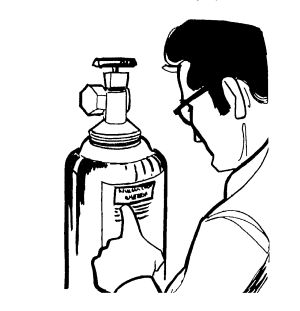| Compressed Gas Cylinder Safety |

|
|
1 - Compressed Gas Cylinder Safety
2 - Page 2 3 - Page 3 4 - Page 4 |

 HOME
HOME  |
Compressed gases present a unique hazard. Depending on the particular gas, there is a potential for simultaneous exposure to both mechanical and chemical hazards. Gases may be:
- Flammable or combustible
- Explosive
- Corrosive
- Poisonous
- Inert
- or a combination of hazards
If the gas is flammable, flash points lower than room temperature compounded by high rates of diffusion present a danger of fire or explosion. Additional hazards of reactivity and toxicity of the gas, as well as asphyxiation, can be caused by high concentrations of even harmless gases such as nitrogen.
Since the gases are contained in heavy, highly pressurized metal containers, the large amount of potential energy resulting from compression of the gas makes the cylinder a potential rocket or fragmentation bomb (See "The One That Got Away").
Careful procedures are necessary for handling the various compressed gases, the cylinders containing the compressed gases, regulators or valves used to control gas flow, and the piping used to confine gases during flow.
 |
Identification
The contents of any compressed gas cylinder must be clearly identified.
Such identification should be stenciled or stamped on the cylinder or a label. Commercially available three-part tag systems may also be used for identification and inventory.
No compressed gas cylinder should be accepted for use that does not legibly identify its contents by name. If the labeling on a cylinder becomes unclear or an attached tag is defaced to the point the contents cannot be identified, the cylinder should be marked "contents unknown" and returned directly to the manufacturer.
Always read the label!!
Never rely on the color of the cylinder for identification. Color coding is not reliable because cylinder colors may vary with the supplier. Additionally, labels on caps have little value because caps are interchangeable.
The labels should be color coded to distinguish hazardous gases (such as flammable, toxic, or corrosive substances) (e.g., a yellow background and black letters).
Signs should be conspicuously posted in areas where flammable compressed gases are stored, identifying the substances and appropriate precautions (e.g., HYDROGEN - FLAMMABLE GAS - NO SMOKING - NO OPEN FLAMES).
| [1] 2 3 4 Next >> |
